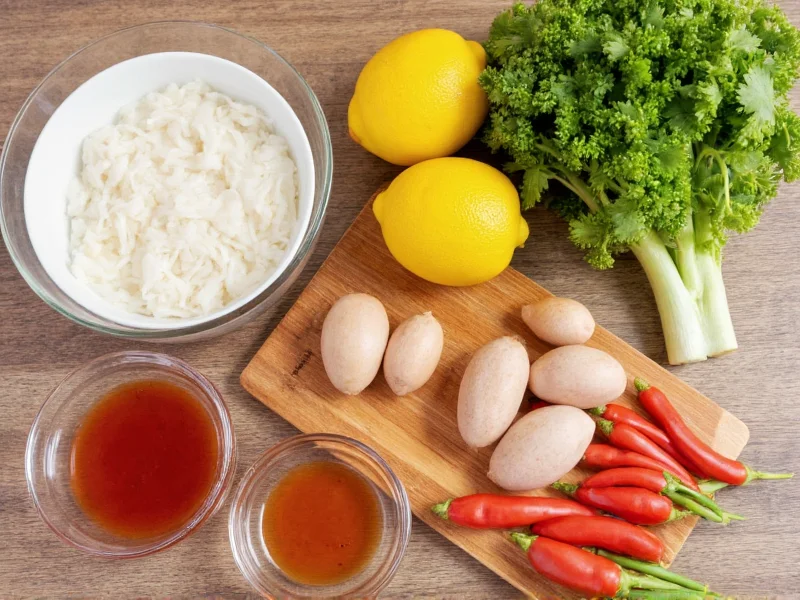Hot and sour soup isn't just a simple broth—it's a carefully balanced symphony of flavors where each ingredient plays a critical role. Understanding the authentic hot and sour soup ingredients list transforms this dish from a bland imitation to a restaurant-quality experience in your own kitchen. The magic happens when the tangy vinegar notes harmonize with spicy elements, creating that distinctive Sichuan sensation that warms you from the inside out.
Core Hot and Sour Soup Ingredients Explained
While regional variations exist across China, the traditional Sichuan hot and sour soup components follow specific principles that maintain the essential flavor balance. Let's examine each critical ingredient and its role in creating the perfect bowl.
Bamboo Shoots: The Textural Foundation
Shredded bamboo shoots provide the signature crunch that contrasts beautifully with the soup's silky broth. Fresh bamboo shoots are ideal, but canned versions work well for most home cooks. When selecting canned bamboo shoots for hot and sour soup, look for 'hearts of bamboo' for the most tender texture. Properly prepared bamboo shoots absorb surrounding flavors while maintaining their distinct bite—a crucial element in authentic preparation.
Wood Ear Mushrooms: The Secret Texture Element
Dried wood ear mushrooms (also called cloud ears) might seem optional, but they're actually essential for traditional hot and sour soup ingredients. These unusual-looking fungi rehydrate into delicate, slightly crunchy ribbons that add dimension to each spoonful. Unlike flavorful shiitakes, wood ears contribute primarily texture rather than taste, making them irreplaceable in the authentic recipe. Soak dried wood ears in warm water for 20 minutes before slicing them into thin strips for optimal results.
Vinegar: The Tangy Heartbeat
The 'sour' in hot and sour soup comes primarily from vinegar, but not just any vinegar will do. Chinese black vinegar (Chinkiang vinegar) provides the complex, malty tang that defines authentic preparation. When unavailable, a combination of rice vinegar and a splash of balsamic creates a reasonable substitute. The vinegar-to-spice ratio determines your soup's character—too little and it lacks dimension, too much and it overwhelms the delicate balance. For traditional Sichuan hot and sour soup components, add vinegar gradually at the end of cooking to preserve its bright acidity.
Spice Elements: More Than Just Heat
White pepper—not chili oil—is the traditional heat source in authentic hot and sour soup ingredients. Its floral, earthy warmth penetrates differently than chili heat, creating the distinctive 'hot' element. Fresh ginger and garlic form the aromatic base, while Sichuan peppercorns (used sparingly) provide that characteristic mouth-tingling mala sensation. For vegetarian hot and sour soup ingredient variations, these spice elements remain unchanged—only the broth base requires substitution.
| Essential Ingredient | Traditional Amount (for 4 servings) | Critical Function |
|---|---|---|
| Chicken or vegetable broth | 4 cups | Flavor foundation |
| Chinese black vinegar | 2-3 tbsp | Signature sourness |
| White pepper | 1 tsp | Distinctive heat |
| Dried wood ear mushrooms | 10g (rehydrated) | Textural contrast |
| Bamboo shoots | ½ cup shredded | Crunchy texture |
| Firm tofu | ½ cup cubed | Protein element |
Ingredient Substitutions That Won't Compromise Authenticity
When certain traditional Sichuan hot and sour soup components aren't available, smart substitutions maintain the dish's integrity. Understanding which hot and sour soup ingredient substitutions work—and which don't—is crucial for home cooks.
Vegan and Vegetarian Adaptations
Replacing chicken broth with high-quality mushroom or kombu broth creates excellent vegetarian hot and sour soup ingredient variations. The key is building umami depth through dried shiitake mushrooms and a small piece of kombu simmered in the broth. Avoid soy-based 'vegetarian chicken' broths, which introduce competing flavors that disrupt the delicate balance.
Wood Ear Mushroom Alternatives
While fresh wood ears are ideal, they're rarely available outside Asia. When using dried versions (the standard for authentic preparation), avoid over-soaking which makes them rubbery. If completely unavailable, thinly sliced fresh shiitake stems can provide textural contrast, though the flavor profile will differ slightly from traditional Sichuan hot and sour soup components.
Avoiding Common Ingredient Mistakes
Many home recipes for hot and sour soup contain critical errors that transform this elegant dish into a muddy, one-dimensional soup. Understanding authentic hot and sour soup ingredients prevents these common pitfalls.
The Cornstarch Trap
While American-Chinese versions often feature a thick, gravy-like consistency, traditional Sichuan hot and sour soup has a light, broth-like texture. Excessive cornstarch creates an unpleasant mouthfeel that masks the delicate flavor balance. For proper hot and sour soup ingredient proportions, use just enough slurry (1 tbsp cornstarch to 2 tbsp water) to give the broth a subtle sheen without thickness.
Vinegar Timing Matters
Adding vinegar too early during cooking causes its volatile compounds to evaporate, leaving only sharp acidity without complexity. The authentic preparation method calls for adding vinegar in the final minute of cooking. This preserves the nuanced flavor profile that defines traditional Sichuan hot and sour soup components.
Building Flavor Balance: The Art of Proportions
The difference between exceptional hot and sour soup and a mediocre version lies in ingredient proportions. Authentic hot and sour soup ingredients follow precise ratios that create harmony between competing elements.
Start with a neutral broth base, then build layers: ginger and garlic for aroma, white pepper for heat, vinegar for sourness. The magic happens when these elements reach equilibrium—where no single component dominates. Taste and adjust incrementally, remembering that flavors continue developing even after removing from heat. For perfect hot and sour soup ingredient proportions, maintain a 3:1 ratio of broth to vinegar, with white pepper adjusted to personal tolerance.
Final Touches That Elevate Your Soup
The authentic preparation includes finishing touches that transform good hot and sour soup into extraordinary. A thin ribbon of beaten egg stirred in at the end creates delicate strands that enhance texture without overwhelming. For restaurant-quality results with your hot and sour soup ingredients, drizzle with a few drops of sesame oil just before serving—this adds aromatic complexity without competing with the primary flavors.











 浙公网安备
33010002000092号
浙公网安备
33010002000092号 浙B2-20120091-4
浙B2-20120091-4